Inset Kitchen Cabinets: A Detailed Buying Guide
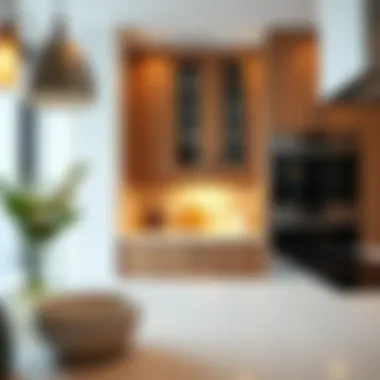
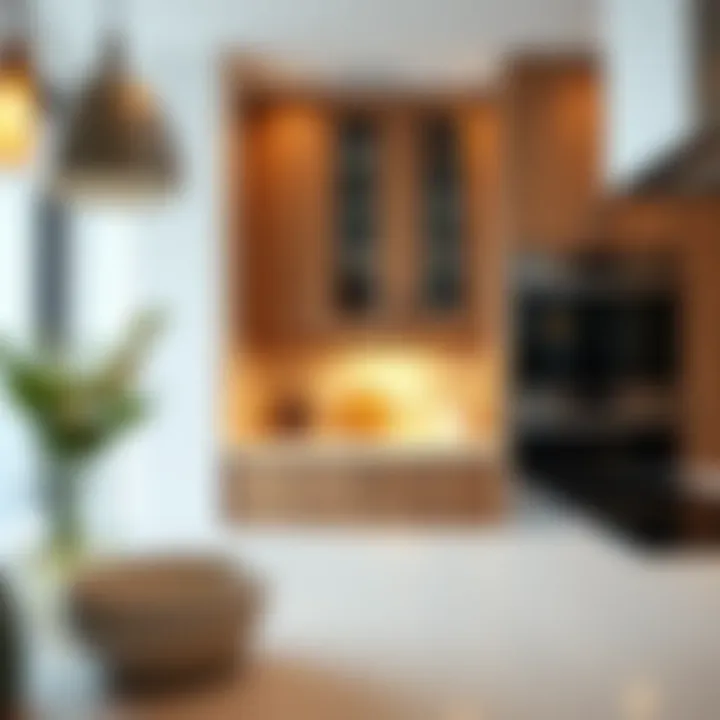
Intro
When it comes to kitchen design, few elements make a statement quite like inset kitchen cabinets. These cabinets are not just functional; they add charm, distinction, and a touch of luxury to any culinary space. If you're considering a renovation, understanding the ins and outs of inset kitchen cabinets can be a game changer. From their design pedigree to practical installations, this guide will delve into everything you need to know to make an informed choice.
Inset cabinets are unique because the doors sit flush with the frame, creating a clean, seamless look that’s highly coveted among homeowners at all stages of life. Whether you're a budding DIY enthusiast or a seasoned designer, the insights shared here aim to illuminate all pathways to effectively integrating inset cabinets into your kitchen.
Furniture Design Trends
In the ever-evolving realm of kitchen aesthetics, staying abreast of the latest furniture design trends can be quite the challenge. However, certain styles continue to shine brightly in modern homes.
Current Styles and Aesthetics
When we talk about current styles in kitchen design, it’s like a mixed bag of influences. Traditional designs often feature raised panel doors, while modern takes are simplifying things, leaning toward flat panels. The minimalist aesthetic is particularly prevalent today, favoring clean lines and uncluttered spaces.
Classic styles like Shaker remain a popular choice because of their versatility. Shaker cabinets offer a timeless aesthetic while accommodating both traditional and contemporary environments.
Color Palettes and Materials
As for color palettes, it's interesting to note the shift from stark whites to moods that evoke a sense of warmth. Natural wood tones, deep blues, and even dark greens are making a splash in kitchens. These choices not only complement the various materials used but are also reflective of a broader trend towards creating more inviting spaces.
Regarding materials, solid wood maintains its appeal, but engineered options like plywood are on the rise due to their durability and cost-effectiveness. Pairing high-quality finishes with thoughtful design choices can create a substantial visual impact.
Buying Guides
Navigating the market for inset kitchen cabinets can feel overwhelming unless you know what to look for. This is where a solid buying guide comes in handy.
Essential Considerations When Purchasing
Here are some essential considerations to keep in mind:
- Quality: Always inspect the cabinet construction. Look for solid wood rather than particle board.
- Size: Measure your available space meticulously to avoid surprises.
- Style Compatibility: Ensure that the cabinet style aligns with your overall kitchen design.
- Cost: Set a budget before you start shopping; inset cabinets can vary widely in price based on materials and craftsmanship.
Top Recommendations for Different Budgets
For those on a tighter budget, brands like IKEA and Home Depot offer some attractive options without sacrificing quality. For mid-range selections, consider Cabinets To Go or Wayfair, where you can find stylish choices that won’t break the bank.
If you’re looking at a more luxurious range, Custom Cabinetry from high-end manufacturers such as Miele or Rutt may be more your speed, offering bespoke experiences tailored to fit your unique style and space.
"Cabinets reflect your kitchen’s personality. Choose wisely."
From these insights, you can muster a clearer picture of how to approach the purchase of your inset kitchen cabinets. The key is merging your style preferences with practical requirements to create a kitchen that is not only beautiful but also functional. Next up, we’ll explore installation tips to ensure these elements come together smoothly.
Understanding Inset Kitchen Cabinets
Understanding inset kitchen cabinets is pivotal for homeowners and designers alike. This style offers a refined appearance and seamlessly integrates with the overall aesthetic of your kitchen. The way these cabinets sit flush with the frame creates a polished look that not only compliments traditional designs but also elevates modern ones. It’s essential to grasp not just how they look but also what makes them a practical choice for kitchen renovations. Their functionality, blend with decor, and long-lasting qualities make them a popular choice.
Definition and Characteristics
Inset kitchen cabinets are distinct in their construction and appearance. Unlike traditional cabinet designs that overlay the cabinet frame, inset cabinets are crafted to fit inside the frame, hence the name. This adjustment leads to a clean lines aesthetic that is hard to ignore.
Characteristics of inset kitchen cabinets include:
- Flush Installation: Doors are level with the cabinet frame, offering a streamlined look.
- Precise Alignment: The craftsmanship in these cabinets often reflects high degrees of precision, showcasing meticulous attention to detail.
- Material Options: These cabinets typically use solid wood, which enhances their durability and visual appeal.
Beyond this, home chefs often appreciate the ease of access to contents, as inset cabinets can be designed for complete accessibility.
Historical Context
The origins of inset kitchen cabinets can be traced back to the early 1800s. These cabinets became prominent when homeowners sought more durable, crafted wooden furniture. Traditional joinery techniques were employed to ensure that each piece fit snugly into the kitchen's architecture. Throughout the years, their popularity ebbed and flowed with homeowners' shifting tastes and industrial changes. Their resurgence in recent years coincides with a growing interest in vintage-style kitchens, where elegance meets functionality.
Interestingly, contemporary designers often draw inspiration from these historical practices, mixing the past's charm with modern-day needs. This evolution reflects how design trends recycle and revitalise. The careful crafting of inset cabinets today pays homage to a time when craftsmanship was paramount.
"The value of wood cabinetry isn’t just in its appearance, but in the stories it can tell through generations."
As we peel back the layers of inset kitchen cabinets, their historical significance coupled with modern functionality emerges clearly. This style of cabinetry not only satisfies the practical requirements of storage and utility but also speaks volumes of personal style and aesthetic preference.
Benefits of Inset Kitchen Cabinets
When it comes to customizing your kitchen space, inset kitchen cabinets shine with benefits that set them apart in the crowded cabinetry market. In this section, we’ll explore the advantages these cabinets bring to your home, underscoring the specific elements that make them an appealing choice for many homeowners and designers alike. From their striking visual appeal to functionality and durability, inset cabinets are not just a practical addition but a statement piece in your kitchen.
Aesthetic Appeal
The visual charm of inset kitchen cabinets is often the first thing that catches the eye. Unlike traditional overlay cabinets, where the doors sit atop the frame, inset cabinets are flush with the frame, creating a seamless, integrated look. This design lends a certain elegance and sophistication to kitchen interiors.
- Timeless Design: The flush door style allows for various aesthetics like modern, traditional, or even farmhouse, making them versatile.
- Customization: Homeowners can personalize these cabinets with various hardware finishes, enabling a unique look that reflects individual taste.
- Clean Lines: The flush installation minimizes gaps and protrusions, providing a cleaner, more minimalist look.
Inset cabinets tend to harmonize beautifully with a range of color schemes, adding to their allure. They can make a small kitchen appear more spacious by eliminating visual clutter. Overall, the aesthetic benefits of inset kitchen cabinets are compelling for any homeowner looking to enhance their space.
Superior Functionality
Moving beyond looks, the functionality of inset cabinets deserves a thorough examination. Their design isn’t just for show; there are practical benefits that enhance how the kitchen operates.
- Maximized Space: Since the doors fit perfectly within the frame, there’s little wasted space, making it easier to fully utilize cabinet interiors.
- Ease of Access: The flush doors allow for a full opening, which can facilitate easier access to items stored within. This can be particularly useful in larger kitchens where reaching into the back of a cabinet can be a hassle.
- Ruggedness: The construction of inset cabinets tends to incorporate stronger materials, lending themselves to durability over time.
More than just aesthetics, the design nuances of inset cabinets can lead to enhanced organization and functionality, making them a smart choice in kitchen design.
Enhanced Durability
When investing in kitchen cabinetry, durability is often a key consideration. Inset kitchen cabinets come packed with materials and construction methods that prioritize longevity.
- Robust Construction: Many inset cabinets are crafted from solid wood or high-grade materials that withstand wear and tear better than lesser quality options.
- Hardware Quality: The hinges and slides incorporated into these cabinets are typically designed for durability, often being hidden from view, which simplifies maintenance and improves the overall aesthetic.
- Timeless Choice: Unlike trends that may fade, the understated style of inset cabinets keeps them looking fresh and relevant over the years, reducing the need for replacements or upgrades.
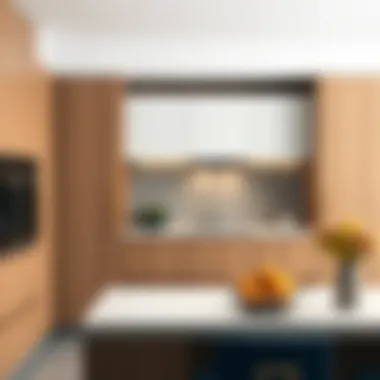
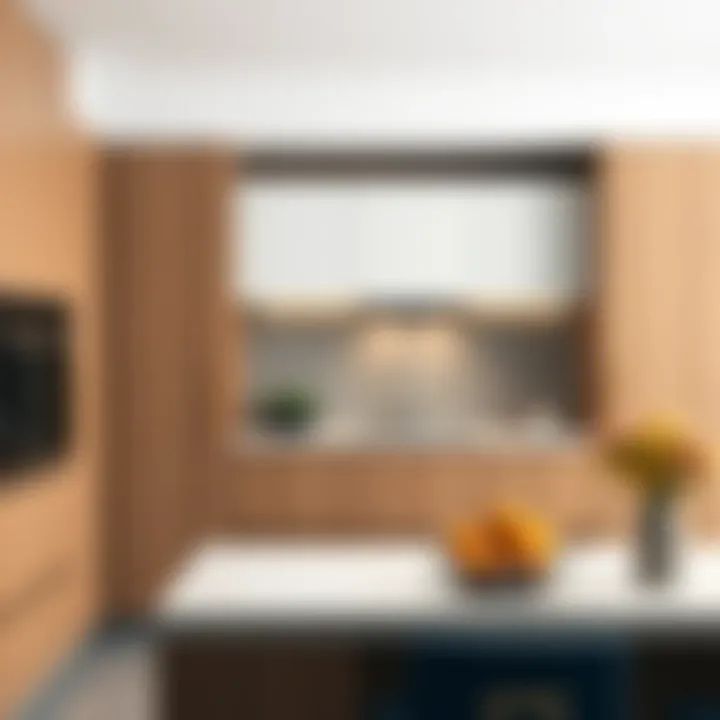
In terms of long-term investment, inset kitchen cabinets provide peace of mind that you won’t be scrambling for repairs or replacements any time soon.
Consider investing in high-quality inset cabinets that not only meet your style but also your functional needs. The balance between form and function is key.
With their aesthetic benefits, superior functionality, and enhanced durability, inset kitchen cabinets represent an excellent choice for those looking to improve their kitchen's dynamics while keeping their style in mind.
Types of Inset Kitchen Cabinets
When it comes to inset kitchen cabinets, understanding the various types available can significantly enhance your overall renovation experience. Choosing the right type means considering both aesthetics and functionality to suit your specific kitchen requirements. This section sheds light on two critical aspects of inset kitchen cabinets: Material Options and Style Variations.
Material Options
Solid Wood
Solid wood cabinets hold a prominent place in kitchen design, renowned for their durability and natural charm. This material, sourced from various hardwoods such as oak, maple, or cherry, is synonymous with quality. One of the key characteristics of solid wood is its ability to withstand wear and tear over time. Homeowners often gravitate towards solid wood because of its unique grain patterns, which can add a personalized touch to any kitchen.
However, it’s important to note that solid wood comes with its own set of challenges. For instance, it’s susceptible to changes in humidity, which can lead to warping or cracking. Nonetheless, for those who value longevity and aesthetics, solid wood remains a reliable choice.
Veneer
Veneer cabinets offer a veneer of luxury at a fraction of the cost of solid wood. This material involves a thin layer of real wood adhered to a core made typically of engineered materials. A notable advantage of veneers is their striking appearance; they can mimic the look of solid wood without the hefty price tag. Builders and homeowners alike appreciate veneers for their versatility, allowing for various finishes and designs.
Nevertheless, veneer cabinets can be less durable than solid wood. They may not hold up as well against moisture and may require careful handling. It’s essential to consider these factors while making a decision on cabinetry.
MDF (Medium-Density Fiberboard)
MDF is a product made by breaking down hardwood and softwood into wood fibers, combining it with wax and resin, and then forming it into panels. This material is increasingly popular owing to its smooth surface finish and resistance to warping. In the realm of budget-friendly materials, MDF is a champion choice. Its affordability makes it an attractive option for those looking to balance cost and quality in cabinetry.
However, MDF is not without its drawbacks. It tends to be heavier than solid wood and is less durable overall. In settings prone to high moisture, MDF can swell and deteriorate, leading to potential issues in maintenance and longevity. Still, for many, its ease of customization often outweighs these concerns.
Style Variations
Traditional
Traditional style cabinets evoke a sense of timeless elegance and grace. These cabinets often feature intricate details, such as raised panel doors and crown molding. The classical profile complements a wide serving of kitchen designs, making it a go-to choice for homeowners aiming for a cozy, inviting ambiance.
However, traditional cabinets can require more maintenance due to their intricate woodwork. Their high-end look often comes with a corresponding price point, making this style a significant investment for many.
Modern
Modern cabinets focus on sleek lines and minimalistic aesthetics, focusing on functionality without compromising style. The clean, geometric shapes dominate contemporary spaces and often utilize innovative materials like glass or steel. Their streamlined appearance appeals to those wanting a fresh, uncluttered look in their kitchens.
Yet, the modern design might lack the warmth of traditional styles, which some homeowners find off-putting. Furthermore, if you're looking for ornate detail and texture, modern cabinets may feel too stark.
Farmhouse
Farmhouse style cabinets are known for their rustic charm and homey feel. Characterized by their simplicity, these cabinets often incorporate distressed finishes and open shelving, evoking a cozy, welcoming atmosphere. This style is particularly popular among those wanting to create a warm, casual kitchen space.
On the downside, farmhouse cabinetry can require more frequent touch-ups, especially if scratches and dents are a concern. Also, as the style leans towards casual living, it might not fit well with more elegant or contemporary design aesthetics.
Choosing the right type of inset kitchen cabinets can vastly influence the functionality and look of your kitchen. Think about both style and material to find the best match for your unique needs!
Finding Inset Kitchen Cabinets for Sale
When it comes to enhancing one’s kitchen, selecting the right inset cabinets is crucial. They don’t just offer utility; they also contribute significantly to the overall aesthetics of the space. This section dives into the various avenues available for sourcing these cabinets, shedding light on the unique aspects each option offers and why they matter to homeowners, designers, and DIY enthusiasts.
Physical Retailers
Physical retailers serve as one of the most traditional sources for purchasing inset kitchen cabinets. Visiting a store has its advantages, enabling buyers to see materials firsthand, to interact with showroom displays, and to consult knowledgeable sales personnel. These interactions can prove beneficial, especially for those who require guidance on selection based on their renovation needs.
In a typical local showroom, buyers might encounter a range of styles, from vintage-inspired designs to sleek modern finishes. The tactile experience is invaluable; you can feel the weight of solid wood versus the lighter composite materials. Additionally, many showrooms offer custom options that can cater to specific measurements or design preferences, making it easier to envision how the cabinets fit into the broader context of your kitchen renovation.
A few pointers when visiting physical retailers:
- Bring your measurements: Having exact dimensions helps make informed decisions more precise.
- Ask about warranties: Understanding the warranty can provide peace of mind regarding your investment.
- Take photos: Capturing the details you may not recall can be helpful for later discussions.
Online Marketplaces
Online marketplaces have transformed how individuals shop for inset cabinets, offering convenience and a wider selection. Shopping online means being able to explore countless styles and materials without the limitations of geographic boundaries. Websites like Houzz or Wayfair provide extensive catalogs, complete with customer reviews that can guide decisions.
However, buyers need to tread carefully; quality can vary significantly between vendors. It’s crucial to read up on reviews and possibly connect with customer service to clarify doubts. One key element of online shopping is ensuring that any piece you purchase comes with robust return policies and ample product descriptions, especially for larger items like cabinets that are more challenging to return.
When shopping online, consider these tips:
- Compare prices across platforms: Take time to find the best deal.
- Check installation requirements: Make sure you understand what's needed for set-up before purchasing.
- Read customer feedback: Honest reviews can provide insights into durability and appearance.
Custom Builders
For homeowners seeking a truly tailored experience, custom builders represent the pinnacle of kitchen cabinetry solutions. These professionals can craft inset cabinets that fit the exact specifications of your kitchen space while embodying your aesthetic vision. Custom builders usually follow a holistic design philosophy, ensuring that every element—from material choice to color schemes—aligns with the homeowner's preferences.
Engaging with a custom builder typically begins with a consultation, where you’ll discuss expectations, budgets, and timelines. The customization process might involve multiple steps, including sketches, material samples, and prototypes, thus necessitating a collaborative approach between you and the builder.
Key considerations when working with custom builders include:
- Clear Communication: Articulate your vision and requirements to minimize misunderstandings.
- Review Past Projects: Looking at a builder's portfolio can provide insight into their ability to deliver your desired style.
- Budget Restrictions: Custom work can be pricier, making it vital to establish financial parameters early on.
By weighing the pros and cons of each avenue, homeowners and enthusiasts can find the perfect fit for their inset kitchen cabinetry needs. This exploration helps facilitate informed decisions, blending aesthetics with functionality effectively.
Price Considerations
When venturing into the world of inset kitchen cabinets, understanding the price considerations is nothing short of crucial. This section can serve as a compass, guiding homeowners and enthusiasts alike to make the right choices tailored to their needs and budgets. Emphasis on price does not only reflect how much one may part with but also encapsulates the intricacies associated with it, from the materials used to the reputability of the brand. Choosing cabinets is not just making a purchase; it's about investing in a space that will endure the test of time, both in style and function.
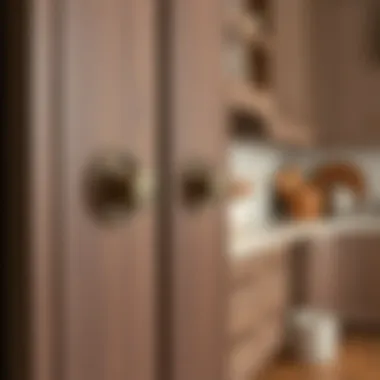
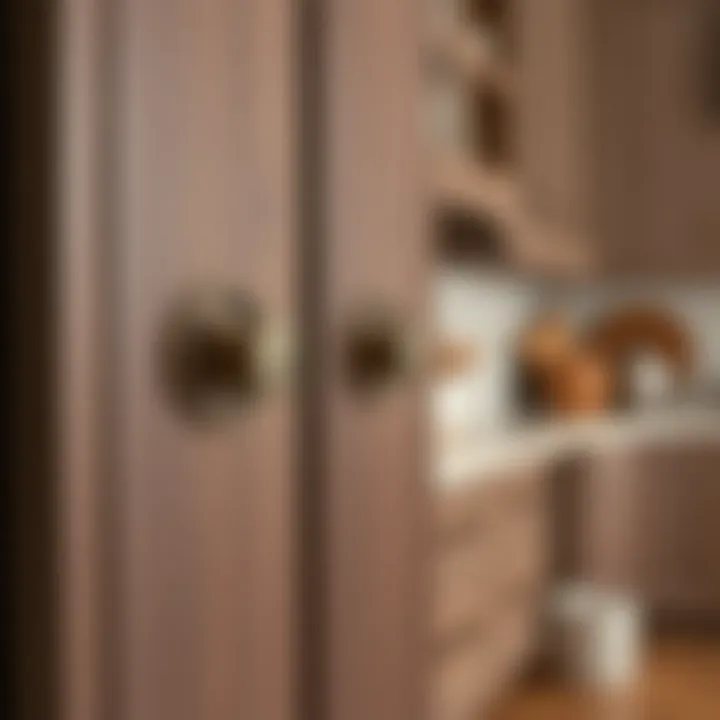
Average Cost Breakdown
In the realm of cabinetry, the costs can swing wildly based on various factors. On average, homeowners can expect to fork out anywhere between $2000 to $5000 for a full kitchen's worth of inset cabinets. This price includes not just the cabinets but also the tailored design, finishing touches, and hardware that complete the aesthetic.
An average cost breakdown can provide clarity:
- Base Cabinets: $150 to $800 each
- Wall Cabinets: $100 to $600 each
- Custom Options: Up to $1500 per cabinet
- Hardware & Accessories: $50 to $200 per set
While these figures help sketch out a budget, always consider your personal style and functional needs, which could sway final choices.
Factors Influencing Price
Price isn't a one-size-fits-all concept, especially when we're talking about inset kitchen cabinets. Several elements play into the final figure that homeowners encounter, each bringing something unique to the table.
Materials
Materials have a hefty impact on the overall budget. When it comes to cabinetry, they aren’t just building blocks – they shape durability, aesthetics, and longevity. Solid wood, often hailed as a premium choice, holds its ground through the years, developing a character that only age can offer. Plywood and MDF present affordable alternatives that don’t skimp on quality, albeit with nuances in finish and resilience.
- Characteristics: Solid wood is revered for its durability but comes with a heavier price tag.
- Unique Features: Plywood and MDF, while more budget-friendly, can chip or warp under certain conditions.
The choice of material fundamentally sets the tone for your cabinets, affecting both the visual appeal and wallet-friendliness.
Design Complexity
The artistry involved in the cabinet's design also bears weight on price. If you’re leaning towards intricate patterns or custom shapes, prepare for the costs to climb. Simpler designs typically allow for quicker production and installation, which can keep a budget in check.
- Characteristics: Basic designs can offer cost savings while still providing elegance.
- Unique Features: Feaures such as raised panels or intricate moldings generally bump up prices due to the craftsmanship involved.
Choosing a design that efficiently melds form and function can yield the best return on investment.
Brand Reputation
Brand reputability can significantly influence pricing. Renowned brands that have established themselves as industry leaders might charge a premium, but they often come with assurances of quality, craftsmanship, and customer service.
- Characteristics: Trusted brands offer durability and reliability based on longstanding performance.
- Unique Features: Some newer or lesser-known brands may present lower prices but could lack in customer support or warranty options.
In summary, searching for inset kitchen cabinets involves more than just picking a favorite design or color. It's a balancing act of considerations: materials, design complexity, and brand reputation, each contributing to the ultimate cost. For anyone embarking on a kitchen renovation, being armed with these insights is paramount to crafting a kitchen space that doesn’t just look good but feels right too.
Installation Overview
When it comes to inset kitchen cabinets, understanding the installation process is as crucial as selecting the right design or material. The way cabinets are installed not only affects their functionality but also impacts the overall aesthetic of the kitchen. A well-installed cabinet ensures that doors close properly, aligns correctly with the countertops, and provides ample storage without sacrificing style. Therefore, knowing the ins and outs of installation can save homeowners from costly mistakes and headaches down the road.
Professional vs. DIY
The debate between hiring a professional and opting for a do-it-yourself approach is as old as time, especially in the realm of home improvement. Each option has its pros and cons, catering to different homeowner needs and skills.
Hiring a Professional:
While it may stretch the budget a bit, enlisting expert help can ease the anxiety that comes with installation. Professionals come with experience and tools that a typical homeowner might lack. They ensure that everything is level and correctly aligned.
Benefits of Professional Installation:
- Expertise in the Field: Know-how can drastically reduce mistakes.
- Time Efficiency: Professionals tend to work faster without sacrificing quality.
- Warranty Protection: Many installers offer guarantees on their work, providing peace of mind.
Going the DIY Route:
For those inclined toward hands-on projects, installing cabinets themselves can be a rewarding experience. However, DIY means more than just a hammer and nails. It requires planning, measuring, and understanding common pitfalls.
Pros of DIY Installation:
- Cost Savings: No labor charges can lead to significant savings.
- Personal Satisfaction: Taking pride in your handiwork is unbeatable.
- Flexibility in Timing: Work at your own pace, fitting it into your schedule.
Ultimately, the choice comes down to the homeowner's confidence in their skills and the complexity of their kitchen layout.
Step-by-Step Installation Guide
Installing inset kitchen cabinets can seem daunting, but breaking it down into steps makes the process more manageable. While each kitchen may have its quirks, the fundamentals remain consistent. Here’s a concise guide to help navigate through the installation:
- Gather Tools and Materials:
- Prepare the Space:
Clear the area, remove old cabinetry if necessary, and ensure the walls are in good repair without protruding nails or screws. - Layout Planning:
Use chalk or a pencil to map out where the cabinets will be placed. It’s crucial to do a dry run with the layout for space confirmation. - Install Upper Cabinets First:
- Install Base Cabinets:
- Align Doors and Drawers:
Take the time to adjust hinges; even a small misalignment can cause problems later. - Finishing Touches:
- Final Inspection:
- Drill and drill bits
- Level
- Measuring tape
- Clamps
- Screwdriver
- Start with the upper cabinets; attach them directly to the wall studs using screws. Manually secure them, ensuring they are level.
- Work from corner cabinets outward. Again, check each piece for level and adjust as needed. Once positioned, screw them into the wall.
- Install end panels and trim to cover the gaps and ensure everything looks seamless.
- Check all the doors and drawers operate smoothly. Adjust if necessary.
"The devil is in the details."
Making sure each tiny aspect is addressed can make all the difference in your kitchen's functionality and aesthetic.
In summary, whether hiring a professional or taking on the task yourself, understanding the installation nuances is vital. Following a structured approach not only guarantees a better finish but also enhances the joy of having new inset kitchen cabinets in your home.
Maintenance and Care for Inset Cabinets
Taking care of inset kitchen cabinets is not just about cleaning; it's an art that combines maintenance with preservation. These cabinets, known for their precise construction and refined aesthetics, deserve an attentive hand. Neglecting their care can lead to issues that not only affect their appearance but can also diminish their functional qualities. Keeping cabinets in good shape ensures that they serve you well for years, making the initial investment worthwhile.
Regular maintenance can prevent costly repairs or premature replacements, thus preserving the integrity and beauty of your kitchen.
Routine Cleaning Methods
To keep your inset cabinets looking sharp, routine cleaning is essential. Here are some practical methods to consider:
- Gentle Detergents: Use a mixture of mild dish soap and warm water. This combination works well for everyday dirt while being safe for most cabinet finishes.
- Soft Cloths: Always opt for soft, lint-free cloths to wipe down surfaces. Avoid paper towels, as they can scratch finish over time.
- Spot Cleaning: For stubborn stains, dab a bit of vinegar or baking soda on a cloth and gently work it into the stain until it lifts. Be sure to follow up with a damp cloth to remove any residues.
- Drying: After cleaning, always dry the surfaces immediately to avoid any moisture seeping into joints or seams which can lead to warping.
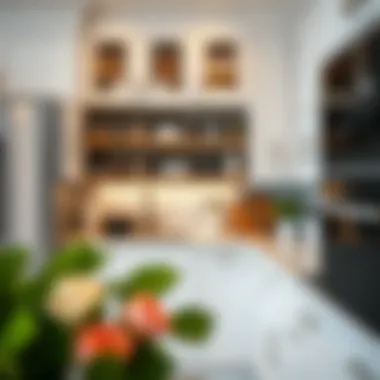
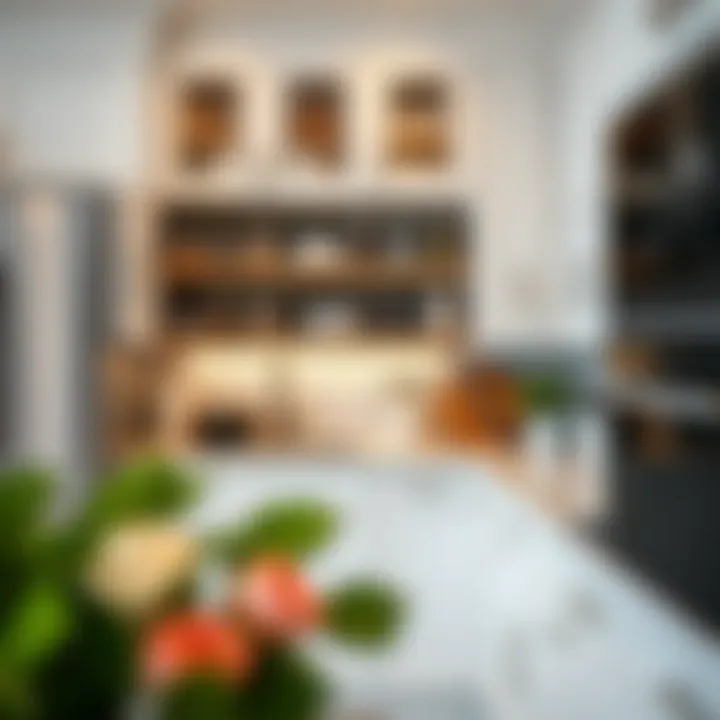
Preventive Measures
Preventing damage before it happens is key in maintaining the life of your inset cabinets. Here are steps you can take:
- Humidity Control: Keep your kitchen's humidity levels in check. Too much moisture can lead to swelling and warping of wood. Using a dehumidifier can be beneficial, especially in warmer months.
- Heat Sources: Avoid positioning appliances that generate heat close to the cabinets. Over time, exposure to excess heat can warp and discolor the wood.
- Regular Inspections: Conduct regular checks for any signs of wear and tear. Look for loose hinges, worn-out handles, or any small damages that need immediate attention.
- Use Sealants: Depending on the finish of your cabinets, applying a protective sealant can add an extra layer of defense against moisture and stains.
"An ounce of prevention is worth a pound of cure."
By following these cleaning routines and preventive measures, homeowners can maintain the beauty and functionality of their inset kitchen cabinets. This attention to detail not only enhances the visual appeal of the kitchen but also reflects a commitment to quality craftsmanship that warrants admiration.
Sustainability in Cabinetry
In today’s world, the importance of sustainability has become a focal point in various industries, and cabinetry is no exception. As more homeowners opt for environmentally friendly choices in their homes, understanding the impact of cabinets' materials and sourcing practices becomes crucial. Emphasizing sustainability helps in minimizing environmental footprints and promoting healthier living spaces. This section explores the sustainable aspects of inset kitchen cabinets, delving into eco-friendly materials and responsible sourcing practices.
Eco-Friendly Materials
When selecting materials for inset kitchen cabinets, it’s vital to consider options that are both durable and friendly to the environment. Here are a few eco-friendly materials worth considering:
- Bamboo: This grass is one of the fastest-growing plants on the planet. It’s robust, adaptable, and readily available, making it a sustainable choice.
- Reclaimed Wood: Utilizing wood from old barns, palettes, or even vintage furniture not only gives a unique flavor to the cabinets but also reduces the demand for new lumber, conserving forests.
- Formaldehyde-Free MDF: Medium Density Fiberboard made without harmful adhesives is a safer alternative that can still provide that seamless, smooth finish many desire in cabinets.
- Low-VOC Finishes: Volatile organic compounds found in many varnishes and paints can hurt indoor air quality. Opting for low-VOC or zero-VOC finishes mitigates this concern and promotes a healthier home.
By choosing such materials, homeowners can enhance the aesthetics of their kitchens while aligning with eco-friendly practices.
Sourcing Practices
Sourcing practices play a decisive role in the sustainability of kitchen cabinetry. Here’s how conscientious sourcing can make a difference:
- Local Suppliers: Purchasing from local businesses minimizes transportation emissions, reducing the cabinet's carbon footprint. Additionally, it supports local economies.
- Sustainable Forest Management: Look for suppliers certified by organizations like the Forest Stewardship Council (FSC). These certifications assure that wood is harvested responsibly, preserving ecosystems and maintaining biodiversity.
- Recycling Programs: Some manufacturers have recycling initiatives for older cabinets, which can be reused or repurposed, diverting waste from landfills and allowing furniture to have a second life.
Identifying vendors who prioritize responsible sourcing not only enriches your cabinetry experience but also contributes to a larger movement toward environmental responsibility.
"Being environmentally conscious in our home choices is not just a trend; it's a necessity for future generations."
Incorporating sustainability into your cabinetry not only reflects a modern, conscious lifestyle but also prepares the way for a more eco-friendly future in home design.
Trends in Kitchen Design
When it comes to planning a kitchen renovation, staying abreast of current trends can make a world of difference. Kitchen design is constantly evolving; what's in vogue today could quickly turn outdated tomorrow. This section dives deep into the latest trends shaping kitchen designs, particularly focusing on some standout aspects that can guide homeowners and enthusiasts in making thoughtful decisions regarding inset kitchen cabinets.
Trends in kitchen design are not just superficial changes; they reflect broader shifts in lifestyle, technology, and environmental awareness. By understanding these trends, readers can not only enhance the visual appeal of their kitchens but also increase their functionality and sustainability.
Contemporary Design Trends
Contemporary kitchen designs often emphasize simplicity, clean lines, and functionality. Think of a space that speaks to modern living without overwhelming the senses. Inset kitchen cabinets are making significant waves in this realm, primarily due to their seamless and flush appearance. This type of cabinetry allows for a streamlined look, which is one of the prominent characteristics of contemporary design.
One popular trend includes the rise of mixed materials. Combining wood with metal or glass not only adds texture but creates visual interest that catches the eye. For instance, a traditional wood inset cabinet paired with stainless steel appliances enhances that modern feel. Moreover, embracing sustainability by choosing eco-friendly materials is becoming increasingly vital, as homeowners are more conscious of their environmental impact.
"The kitchen is the heart of the home, and its design reflects our lifestyle choices and values."
Color Schemes
The right color scheme can transform the entire vibe of a kitchen. Neutral tones combined with pops of color are becoming all the rage, offering a balance that is both visually appealing and easy on the eyes. Shades like soft white, muted gray, and earthy tones complement the natural attractiveness of wood in inset cabinets, reinforced by a few striking colors through accessories or accent walls.
Here are a few key points about trending color schemes:
- Monochromatic Palettes: Incorporating various shades of one color creates an elegant and cohesive look. Consider different hues of blue or green to maintain a serene atmosphere.
- Bold Accent Colors: Juxtaposing bright colors against muted cabinet tones brings out vibrancy. Colors like deep navy or even yellow can add a playful touch.
- Natural-Inspired Shades: Colors that mimic nature, like forest green or terracotta, not only tie the space to its surroundings but also evoke warmth and comfort.
By thoughtfully integrating these trends into your kitchen design, especially when selecting inset cabinets, you can create a space that feels both modern and timeless, reflecting your personal style without sacrificing functionality.
Customer Considerations
When it comes to selecting inset kitchen cabinets, understanding customer considerations is paramount. It’s not just about aesthetics or material choice; it involves a combination of personal taste, functional needs, budget, and overall compatibility with your home’s design. This section aims to illuminate these factors, ensuring that homeowners, designers, and DIY enthusiasts are equipped with the knowledge needed to make informed decisions that align with their specific circumstances and preferences.
Personal Style
The kitchen is often referred to as the heart of the home. Therefore, it’s essential that the style of your cabinets reflects your personal taste. Whether you lean toward a sleek, modern design or a cozy, traditional aesthetic, the choices are endless. An inset cabinet can work like a chameleon, adapting effortlessly to various styles.
- Traditional Charm: If vintage is your game, consider classic wood finishes with intricate details. Think about the warm tones of cherry or oak, which can evoke a sense of nostalgia and timelessness.
- Sleek Modernity: For those who are drawn to a minimalist vibe, you might prefer a high-gloss finish or clean lines. Shades like matte black or white can add a sophisticated edge to your culinary space.
- Personal Touch: Don't shy away from incorporating unique hardware or decorative elements. Handles and knobs in brass or polished chrome can infuse personality into seemingly standard cabinetry.
Ultimately, your cabinets should be a reflection of who you are. Being true to your style not only creates a visually appealing kitchen but can elevate your mood when cooking and entertaining. Think of your cabinets as an extension of yourself, making everyday interactions more meaningful.
Functional Needs
While personal style is undeniably important, it’s equally crucial to consider how your cabinets will function in day-to-day use. Assessing your functional needs can prevent future headaches and ensure that your kitchen is both beautiful and practical.
- Storage Solutions: Different lifestyles demand different storage configurations. If you love cooking, you might need deep drawers for pots and pans or a dedicated space for baking sheets. Customizable inserts for spices and utensils can make meal prep a breeze.
- Accessibility: Think about who will be using the kitchen. If you have children or elderly family members, easy-to-reach shelves and pull-out features could save time and effort.
- Durability Considerations: Your cabinets will endure daily wear and tear; thus, materials should be chosen with durability in mind. Solid wood, while classic and sturdy, may require more upkeep compared to MDF or plywood, which can resist warping in humid climates.
Emphasizing functionality doesn’t mean compromising on style. The most successful designs meld aesthetics with practicality seamlessly. Consider how often you cook, how many people use the kitchen, and what tools you need readily at hand. Designing with these factors in mind will result in a kitchen that feels as good to use as it looks.
"A kitchen should be designed around the things you love mostdelicious smells, great conversations, and lasting memories."
By taking the time to thoughtfully define both your personal style and functional needs, you ensure a well-rounded approach to your inset cabinet selection, leading to a more fulfilling kitchen space.
Closure
In the realm of kitchen design, inset kitchen cabinets are more than just functional storage solutions; they infuse a sense of style and craftsmanship into modern homes. This article has thoroughly explored the multifaceted nature of these cabinets, highlighting their unique construction methods, aesthetic versatility, and practical advantages. One key takeaway is that inset cabinets, while initially requiring a higher investment, often lead to long-term savings through durability and fewer repairs.
When considering inset kitchen cabinets, homeowners and designers alike must weigh various factors, including style preferences and specific functional needs. The emphasis on quality materials and superior craftsmanship in these cabinets enhances their appeal, making them a preferred choice for both traditional and contemporary settings. Moreover, understanding the installation process—differentiating between professional setups and DIY efforts—can significantly affect the final outcome of kitchen renovations.
It's also essential to remember that maintaining these cabinets is straightforward. With regular care, they will retain their beauty and functionality for years to come. Employing eco-friendly materials and practices aligns with the growing trend of sustainability in home design, presenting a compelling case for choosing inset cabinets.
In sum, this guide aims to empower decision-making by providing homeowners and design enthusiasts with the knowledge needed to make informed choices. Investing in inset kitchen cabinets represents not only a home improvement venture but a step towards creating a warm and inviting heart for any household—a space that caters to both cooking and gathering, thus enhancing the overall living experience.
"The kitchen is the heart of the home," a wise saying captures the essence of its importance in daily life. With that in mind, inset cabinets showcase how functionality can harmoniously blend with aesthetic appeal, enriching one's living space.
For more insights, check out Wikipedia on Kitchen Design or HGTV's Design Ideas.
Ultimately, the choice of cabinetry is not just about design; it’s about investing in a space that resonates with your personal style and meets your family's needs.















